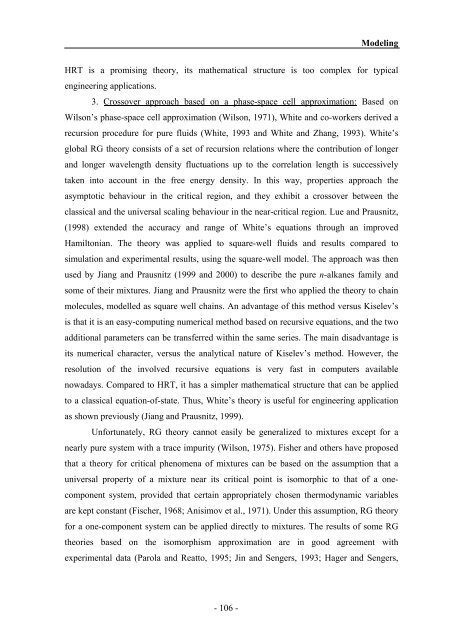n - PATh :.: Process and Product Applied Thermodynamics research ...
n - PATh :.: Process and Product Applied Thermodynamics research ...
n - PATh :.: Process and Product Applied Thermodynamics research ...
Create successful ePaper yourself
Turn your PDF publications into a flip-book with our unique Google optimized e-Paper software.
Modeling<br />
HRT is a promising theory, its mathematical structure is too complex for typical<br />
engineering applications.<br />
3. Crossover approach based on a phase-space cell approximation: Based on<br />
Wilson’s phase-space cell approximation (Wilson, 1971), White <strong>and</strong> co-workers derived a<br />
recursion procedure for pure fluids (White, 1993 <strong>and</strong> White <strong>and</strong> Zhang, 1993). White’s<br />
global RG theory consists of a set of recursion relations where the contribution of longer<br />
<strong>and</strong> longer wavelength density fluctuations up to the correlation length is successively<br />
taken into account in the free energy density. In this way, properties approach the<br />
asymptotic behaviour in the critical region, <strong>and</strong> they exhibit a crossover between the<br />
classical <strong>and</strong> the universal scaling behaviour in the near-critical region. Lue <strong>and</strong> Prausnitz,<br />
(1998) extended the accuracy <strong>and</strong> range of White’s equations through an improved<br />
Hamiltonian. The theory was applied to square-well fluids <strong>and</strong> results compared to<br />
simulation <strong>and</strong> experimental results, using the square-well model. The approach was then<br />
used by Jiang <strong>and</strong> Prausnitz (1999 <strong>and</strong> 2000) to describe the pure n-alkanes family <strong>and</strong><br />
some of their mixtures. Jiang <strong>and</strong> Prausnitz were the first who applied the theory to chain<br />
molecules, modelled as square well chains. An advantage of this method versus Kiselev’s<br />
is that it is an easy-computing numerical method based on recursive equations, <strong>and</strong> the two<br />
additional parameters can be transferred within the same series. The main disadvantage is<br />
its numerical character, versus the analytical nature of Kiselev’s method. However, the<br />
resolution of the involved recursive equations is very fast in computers available<br />
nowadays. Compared to HRT, it has a simpler mathematical structure that can be applied<br />
to a classical equation-of-state. Thus, White’s theory is useful for engineering application<br />
as shown previously (Jiang <strong>and</strong> Prausnitz, 1999).<br />
Unfortunately, RG theory cannot easily be generalized to mixtures except for a<br />
nearly pure system with a trace impurity (Wilson, 1975). Fisher <strong>and</strong> others have proposed<br />
that a theory for critical phenomena of mixtures can be based on the assumption that a<br />
universal property of a mixture near its critical point is isomorphic to that of a onecomponent<br />
system, provided that certain appropriately chosen thermodynamic variables<br />
are kept constant (Fischer, 1968; Anisimov et al., 1971). Under this assumption, RG theory<br />
for a one-component system can be applied directly to mixtures. The results of some RG<br />
theories based on the isomorphism approximation are in good agreement with<br />
experimental data (Parola <strong>and</strong> Reatto, 1995; Jin <strong>and</strong> Sengers, 1993; Hager <strong>and</strong> Sengers,<br />
- 106 -



